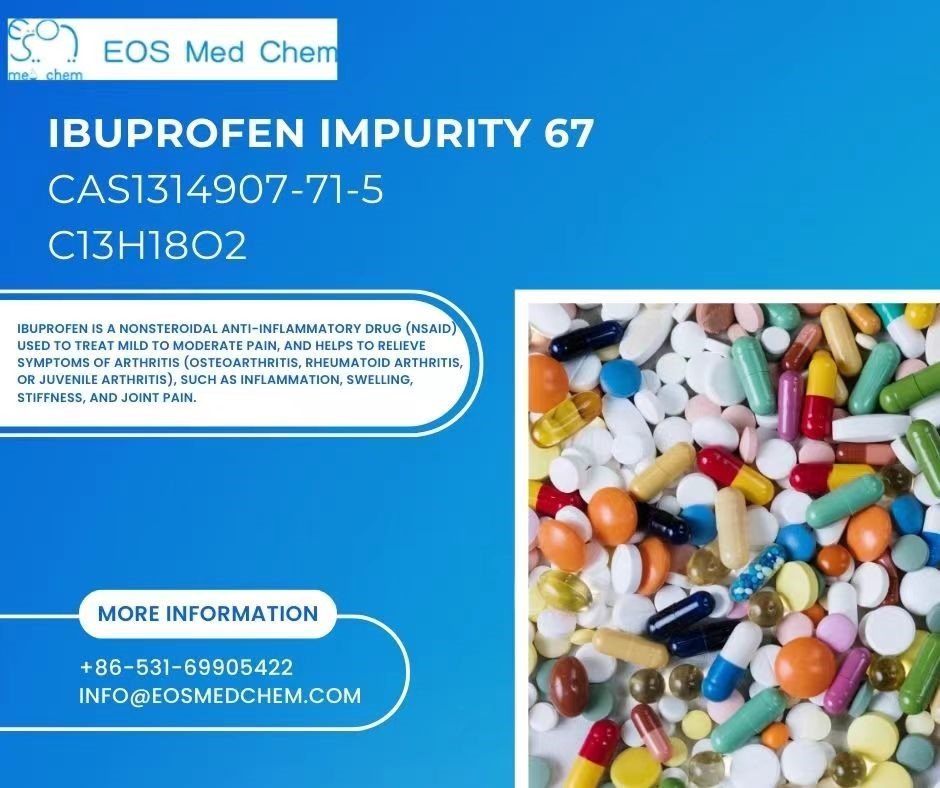UNDERSTANDING IBUPROFEN IMPURITY 67(CAS NO.1314907-71-5)
ali

- Introduction:
Ibuprofen is a widely used nonsteroidal anti-inflammatory drug (NSAID) known for its analgesic and anti-inflammatory properties. However, like any pharmaceutical compound, ibuprofen may contain impurities that can affect its purity and efficacy. One such impurity is Ibuprofen Impurity 67, identified by its Chemical Abstracts Service (CAS No. 1314907-71-5).
- Chemical Properties:
- Molecular Structure
Ibuprofen Impurity 67 (CAS No.1314907-71-5) exhibits a distinct molecular structure, which influences its chemical behavior and interactions within the pharmaceutical formulation.
- Physical Properties:
Understanding the physical properties of the impurity, such as solubility, stability, and reactivity, is crucial for assessing its impact on the overall drug product.
III. Detection and Quantification:
- Analytical Methods:
Various analytical techniques, including chromatography and spectroscopy, are employed to detect and quantify Ibuprofen Impurity 67 (CAS No.1314907-71-5) in pharmaceutical formulations.
- Regulatory Standards:
Regulatory agencies set acceptable limits for impurities, including Ibuprofen Impurity 67 (CAS No.1314907-71-5) to ensure the safety and efficacy of pharmaceutical products.
- Origins and Formation:
- Synthesis Process:
Investigating the synthesis process of ibuprofen is essential to identify potential sources and conditions leading to the formation of Ibuprofen Impurity 67 (CAS No.1314907-71-5).
- Environmental Factors:
External factors, such as storage conditions and exposure to light or heat, can contribute to the generation of impurities during the drug manufacturing process.
- Quality Control and Assurance:
- Pharmaceutical Industry Practices:
Stringent quality control measures are implemented in the pharmaceutical industry to monitor and control impurities, ensuring compliance with regulatory standards.
- Risk Assessment:
Assessing the risk associated with Ibuprofen Impurity 67 (CAS No.1314907-71-5) involves evaluating its potential impact on patient safety and the overall quality of the drug product.
- Implications on Drug Efficacy and Safety:
- Biological Effects:
Understanding the potential biological effects of Ibuprofen Impurity 67 (CAS No.1314907-71-5) is crucial in assessing its impact on the therapeutic properties of ibuprofen.
- Clinical Studies:
Any adverse effects observed in clinical studies related to the presence of Impurity 67 must be thoroughly investigated to ensure patient safety.
VII. Mitigation Strategies:
- Manufacturing Process Optimization:
Modifying the manufacturing process to minimize the formation of Ibuprofen Impurity 67 (CAS No.1314907-71-5) is a proactive approach to ensure product quality.
- Purification Techniques:
Incorporating advanced purification techniques can aid in removing or reducing the levels of Impurity 67 during drug manufacturing.
VIII. Future Perspectives:
- Research and Development:
Ongoing research aims to explore alternative synthesis routes and purification methods to mitigate the presence of Ibuprofen Impurity 67 (CAS No.1314907-71-5).
- Technological Advances:
Advancements in analytical techniques and instrumentation continue to play a crucial role in enhancing the detection and quantification of impurities.
- Impurity Profiling Techniques:
- Chromatographic Methods:
High-performance liquid chromatography (HPLC) and gas chromatography (GC) are widely employed for separating and quantifying impurities, offering precise insights into the impurity profile.
- Spectroscopic Techniques:
Fourier-transform infrared spectroscopy (FTIR) and nuclear magnetic resonance (NMR) spectroscopy provide valuable information about the structural characteristics of Ibuprofen Impurity 67 (CAS No.1314907-71-5).
- Stability Studies:
- Temperature and Humidity:
Stability studies under various temperature and humidity conditions help assess the susceptibility of Ibuprofen Impurity 67 (CAS No.1314907-71-5) to degradation, guiding storage recommendations.
- Forced Degradation Studies:
Accelerated degradation studies simulate harsh conditions to identify potential degradation pathways, aiding in the development of stability-indicating methods.
- Regulatory Compliance:
- International Pharmacopoeias:
Different pharmacopoeias, such as the United States Pharmacopeia (USP) and European Pharmacopoeia (EP), provide guidelines for the Identification and control of impurities, including Ibuprofen Impurity 67 (CAS No.1314907-71-5).
- ICH Guidelines:
The International Council for Harmonisation of Technical Requirements for Pharmaceuticals for Human Use (ICH) sets global standards, and compliance ensures the acceptance of pharmaceutical products in various markets.
XII. Pharmacokinetic Considerations:
- Absorption and Distribution:
Exploring how the presence of Ibuprofen Impurity 67 (CAS No.1314907-71-5) may influence the pharmacokinetics of ibuprofen is crucial for understanding its impact on drug absorption and distribution in the body.
- Metabolism and Excretion:
Investigating whether the impurity undergoes metabolism and affects the excretion profile of ibuprofen provides comprehensive insights into its potential interactions within the body.
XIII. Case Studies and Reported Adverse Events:
- Published Literature:
Analyzing case studies and adverse events reported in the literature related to Ibuprofen Impurity 67 (CAS No.1314907-71-5) aids in understanding its clinical implications and potential risks.
- Post-Marketing Surveillance:
Continuous monitoring through post-marketing surveillance helps identify any emerging concerns or patterns related to the presence of Ibuprofen Impurity 67 (CAS No.1314907-71-5) in marketed pharmaceuticals.
XIV. Emerging Analytical Technologies:
- Mass Spectrometry:
Advancements in mass spectrometry techniques contribute to enhanced sensitivity and specificity in detecting and characterizing impurities, including Ibuprofen Impurity 67 (CAS No.1314907-71-5).
- Machine Learning Applications:
The integration of machine learning algorithms in impurity profiling accelerates data analysis, facilitating quicker identification and quantification of complex impurity mixtures.
- Environmental Impact:
- Waste Management:
Addressing the environmental impact of Ibuprofen Impurity 67 (CAS No.1314907-71-5) includes evaluating waste disposal methods during drug manufacturing to minimize ecological concerns.
- Eco-Friendly Synthesis Approaches:
Research focuses on developing eco-friendly synthesis routes that reduce the generation of impurities, aligning with sustainable pharmaceutical manufacturing practices.
Delving deeper into the realms of impurity profiling, regulatory compliance, pharmacokinetics, and emerging technologies provides a comprehensive understanding of Ibuprofen Impurity 67 (CAS No.1314907-71-5), offering a roadmap for continued research and development in the field of pharmaceutical quality assurance.
- Impurity Profiling Techniques:
- Chromatographic Methods:
High-performance liquid chromatography (HPLC) and gas chromatography (GC) are widely employed for separating and quantifying impurities, offering precise insights into the impurity profile.
- Spectroscopic Techniques:
Fourier-transform infrared spectroscopy (FTIR) and nuclear magnetic resonance (NMR) spectroscopy provide valuable information about the structural characteristics of Ibuprofen Impurity 67 (CAS No.1314907-71-5).
- X. Stability Studies:
- Temperature and Humidity:
Stability studies under various temperature and humidity conditions help assess the susceptibility of Ibuprofen Impurity 67 (CAS No.1314907-71-5) to degradation, guiding storage recommendations.
- Forced Degradation Studies:
Accelerated degradation studies simulate harsh conditions to identify potential degradation pathways, aiding in the development of stability-indicating methods.
- Regulatory Compliance:
- International Pharmacopoeias:
Different pharmacopoeias, such as the United States Pharmacopeia (USP) and European Pharmacopoeia (EP), provide guidelines for the Identification and control of impurities, including Ibuprofen Impurity 67 (CAS No.1314907-71-5).
- ICH Guidelines:
The International Council for Harmonisation of Technical Requirements for Pharmaceuticals for Human Use (ICH) sets global standards, and compliance ensures the acceptance of pharmaceutical products in various markets.
XII. Pharmacokinetic Considerations:
- Absorption and Distribution:
Exploring how the presence of Ibuprofen Impurity 67 (CAS No.1314907-71-5) may influence the pharmacokinetics of ibuprofen is crucial for understanding its impact on drug absorption and distribution in the body.
- Metabolism and Excretion:
Investigating whether the impurity undergoes metabolism and affects the excretion profile of ibuprofen provides comprehensive insights into its potential interactions within the body.
XIII. Case Studies and Reported Adverse Events:
- Published Literature:
Analyzing case studies and adverse events reported in the literature related to Ibuprofen Impurity 67 (CAS No.1314907-71-5) aids in understanding its clinical implications and potential risks.
- Post-Marketing Surveillance:
Continuous monitoring through post-marketing surveillance helps identify any emerging concerns or patterns related to the presence of Ibuprofen Impurity 67 (CAS No.1314907-71-5) in marketed pharmaceuticals.
XIV. Emerging Analytical Technologies:
- Mass Spectrometry:
Advancements in mass spectrometry techniques contribute to enhanced sensitivity and specificity in detecting and characterizing impurities, including Ibuprofen Impurity 67 (CAS No.1314907-71-5).
- Machine Learning Applications:
The integration of machine learning algorithms in impurity profiling accelerates data analysis, facilitating quicker identification and quantification of complex impurity mixtures.
- Environmental Impact:
- Waste Management:
Addressing the environmental impact of Ibuprofen Impurity 67 (CAS No.1314907-71-5) includes evaluating waste disposal methods during drug manufacturing to minimize ecological concerns.
- Eco-Friendly Synthesis Approaches:
Research focuses on developing eco-friendly synthesis routes that reduce the generation of impurities, aligning with sustainable pharmaceutical manufacturing practices.
XVI. Conclusion:
In conclusion, the comprehensive exploration of Ibuprofen Impurity 67 (CAS No.1314907-71-5) encompasses various facets, from analytical techniques and stability studies to regulatory compliance, pharmacokinetic considerations, case studies, emerging technologies, and environmental impact. Continued research and advancements in these areas not only contribute to a deeper understanding of this impurity but also pave the way for Improved drug quality, safety, and sustainability within the pharmaceutical industry. As the field evolves, vigilance in monitoring and addressing impurities remains paramount for ensuring the efficacy and safety of pharmaceutical product .

